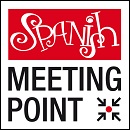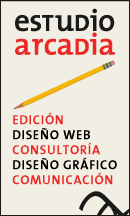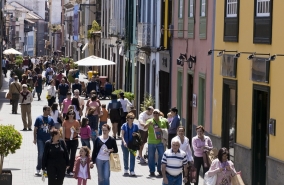Spanish schools and accommodation to study Spanish in Spain
Recent posts
Last schools
introduced
introduced
Learning Spanish in La Laguna. The tourist guide to study your Spanish course.
Why not learn Spanish on a Spanish world heritage city? San Cristobal de la Laguna served as a model for many other Spanish speaking cities constructions in South America, this fact made the city to be considered such a destintion.
General Information. 151,000 inhabitants. Located on the island of Tenerife in the Autonomous Community of the Canary Islands, it is popularly known as La Laguna. It is an inland city, but the beach at Bajamar is just 21 kilometres away. The University of La Laguna, created in 1701, consists of five campuses and offers four halls of residence in and around the university area. San Cristóbal de la Laguna is a very attractive place to study Spanish with some language schools offering a wide range of courses.
Surrounding Areas. Santa Cruz de Tenerife (10 kilometres), the capital of the island. Mount Teide, the highest peak in the whole of Spain, is the stunning centrepiece of the Teide National Park (Parque Nacional del Teide), a UNESCO World Heritage Site. There are two major tourist areas, with beaches and a wide selection of hotels, shops and entertainment options: southern Tenerife, with the beaches of Las Américas and Los Cristianos, and Puerto de la Cruz on the north coast. Punta del Hidalgo, a district belonging to San Cristóbal de la Laguna, with attractive coast and mountain contrasts. Senderos de Anaga (7 kilometres), in the nature reserve of the same name (Parque Natural de Anaga). It is also easy to visit the rest of the Canary Islands.
World Heritage Site. San Cristóbal de la Laguna was declared a World Heritage Site by UNESCO in 1999.
Main Sights. In the old quarter, the neoclassical facade of the Cathedral of Our Lady of Remedies (Catedral de Nuestra Señora de Los Remedios); the Church of the Immaculate Conception (Iglesia Matriz de la Concepción); the Royal Shrine of the Holy Christ of La Laguna (Real Santuario del Santísimo Cristo de la Laguna); Plaza del Adelantado. Also worthy of mention are the Town Hall, two palaces (Palacio de Nava and Palacio Salazar, the headquarters of the Bishopric), and two parks: Parque de la Constitución and Parque de los Dragos. The monuments are a major attraction for the many students who decide to study Spanish in San Cristóbal de la Laguna.
Culture. Campus Rock Festival (June). Certamen Internacional de Tunas Ciudad de La Laguna, a contest featuring groups of university student minstrels from all over the world. San Cristóbal de la Laguna boasts the majority of Tenerife's museums, including the Tenerife History and Anthropology Museum (Museo de Historia y Antropología de Tenerife) and the Museum of Science and the Cosmos (Museo de la Ciencia y del Cosmos), as well as the following cultural institutions: Ateneo de La Laguna, Orfeón La Paz, Casino de La Laguna, La Tertulia de Nava, Teatro Leal and the Paraninfo de la Universidad de La Laguna.
Shopping. In the old quarter you will find numerous small retail outlets, boutiques, souvenir shops, together with a good selection of bars and restaurants, all of which add to the enjoyment of a walk around this historic city centre with its characteristic colonial architecture. There is also a shopping centre called Los Majuelos.
Gastronomy. The typical local dishes and ingredients are common to the whole island. They include gofio, a cereal made from toasted wheat, papas arrugas con mojo picón (‘wrinkled' new potatoes boiled in seawater until the skin is salt-crusted, then baked and served with a cold spicy sauce made from oil, vinegar, paprika, cumin and chilli), conejo en salmorejo (rabbit marinated in wine, vinegar, garlic and spices), and viejas (fish rissoles in a limpet and sea urchin sauce). There are also several good cheeses and excellent wine with Designation of Origin. Among the most typical sweets are the laguneros (puff pastry with a filling made of pumpkin and syrup), and frangollo, a dessert made from flour, raisins, almonds and honey. As La Laguna is a small city, it is easy to find the bars and restaurants in the city centre and the most popular area with students, El Cuadrilátero.
Beaches. Bajamar (21 kilometres), which is three kilometres long and famous for its unusual seawater swimming pools. Playa del Arenal, between Bajamar and Punta del Hidalgo, is a black sand beach and good for surfing. Los Areniscos also has natural swimming pools, and Las Furnias is made up of coves and pools.
Sports. You can play or learn basketball at the Pabellón de Santiago Martín, or go to the Polideportivo Juan Ríos Tejera sports centre and the Francisco Peraza municipal stadium. Water sports, such as snorkelling, surfing and fishing, are very popular at Bajamar and La Punta, and you can also go trekking in the mountains near Anaga.
Fiestas. The city's most important festivities are primarily the Romería de San Benito Abad (beginning of July), a pilgrimage in honour of Saint Benito Abad featuring ox-drawn carriages, folk music bands and groups of revellers known as parrandas, and the fiesta of the Holy Christ of La Laguna (Santísimo Cristo de La Laguna) (September).
Transport. Besides the local buses which cover the whole island and are commonly known as guaguas, there is a tram line linking San Cristóbal de la Laguna with Santa Cruz de Tenerife.
Nightlife. Students who decide to study Spanish in San Cristóbal de la Laguna will discover a very active nightlife, thanks to the city's university atmosphere. There are more than 100 bars and pubs in the university area known as El Cuadrilátero, making it the perfect place for a great night out in La Laguna. There is also lively young atmosphere in the Las Chumberas neighbourhood and in the Las Palmeras shopping and entertainment complex. The discotheques can be found in the Guamasa area, near the airport.
General Information. 151,000 inhabitants. Located on the island of Tenerife in the Autonomous Community of the Canary Islands, it is popularly known as La Laguna. It is an inland city, but the beach at Bajamar is just 21 kilometres away. The University of La Laguna, created in 1701, consists of five campuses and offers four halls of residence in and around the university area. San Cristóbal de la Laguna is a very attractive place to study Spanish with some language schools offering a wide range of courses.
Surrounding Areas. Santa Cruz de Tenerife (10 kilometres), the capital of the island. Mount Teide, the highest peak in the whole of Spain, is the stunning centrepiece of the Teide National Park (Parque Nacional del Teide), a UNESCO World Heritage Site. There are two major tourist areas, with beaches and a wide selection of hotels, shops and entertainment options: southern Tenerife, with the beaches of Las Américas and Los Cristianos, and Puerto de la Cruz on the north coast. Punta del Hidalgo, a district belonging to San Cristóbal de la Laguna, with attractive coast and mountain contrasts. Senderos de Anaga (7 kilometres), in the nature reserve of the same name (Parque Natural de Anaga). It is also easy to visit the rest of the Canary Islands.
World Heritage Site. San Cristóbal de la Laguna was declared a World Heritage Site by UNESCO in 1999.
Main Sights. In the old quarter, the neoclassical facade of the Cathedral of Our Lady of Remedies (Catedral de Nuestra Señora de Los Remedios); the Church of the Immaculate Conception (Iglesia Matriz de la Concepción); the Royal Shrine of the Holy Christ of La Laguna (Real Santuario del Santísimo Cristo de la Laguna); Plaza del Adelantado. Also worthy of mention are the Town Hall, two palaces (Palacio de Nava and Palacio Salazar, the headquarters of the Bishopric), and two parks: Parque de la Constitución and Parque de los Dragos. The monuments are a major attraction for the many students who decide to study Spanish in San Cristóbal de la Laguna.
Culture. Campus Rock Festival (June). Certamen Internacional de Tunas Ciudad de La Laguna, a contest featuring groups of university student minstrels from all over the world. San Cristóbal de la Laguna boasts the majority of Tenerife's museums, including the Tenerife History and Anthropology Museum (Museo de Historia y Antropología de Tenerife) and the Museum of Science and the Cosmos (Museo de la Ciencia y del Cosmos), as well as the following cultural institutions: Ateneo de La Laguna, Orfeón La Paz, Casino de La Laguna, La Tertulia de Nava, Teatro Leal and the Paraninfo de la Universidad de La Laguna.
Shopping. In the old quarter you will find numerous small retail outlets, boutiques, souvenir shops, together with a good selection of bars and restaurants, all of which add to the enjoyment of a walk around this historic city centre with its characteristic colonial architecture. There is also a shopping centre called Los Majuelos.
Gastronomy. The typical local dishes and ingredients are common to the whole island. They include gofio, a cereal made from toasted wheat, papas arrugas con mojo picón (‘wrinkled' new potatoes boiled in seawater until the skin is salt-crusted, then baked and served with a cold spicy sauce made from oil, vinegar, paprika, cumin and chilli), conejo en salmorejo (rabbit marinated in wine, vinegar, garlic and spices), and viejas (fish rissoles in a limpet and sea urchin sauce). There are also several good cheeses and excellent wine with Designation of Origin. Among the most typical sweets are the laguneros (puff pastry with a filling made of pumpkin and syrup), and frangollo, a dessert made from flour, raisins, almonds and honey. As La Laguna is a small city, it is easy to find the bars and restaurants in the city centre and the most popular area with students, El Cuadrilátero.
Beaches. Bajamar (21 kilometres), which is three kilometres long and famous for its unusual seawater swimming pools. Playa del Arenal, between Bajamar and Punta del Hidalgo, is a black sand beach and good for surfing. Los Areniscos also has natural swimming pools, and Las Furnias is made up of coves and pools.
Sports. You can play or learn basketball at the Pabellón de Santiago Martín, or go to the Polideportivo Juan Ríos Tejera sports centre and the Francisco Peraza municipal stadium. Water sports, such as snorkelling, surfing and fishing, are very popular at Bajamar and La Punta, and you can also go trekking in the mountains near Anaga.
Fiestas. The city's most important festivities are primarily the Romería de San Benito Abad (beginning of July), a pilgrimage in honour of Saint Benito Abad featuring ox-drawn carriages, folk music bands and groups of revellers known as parrandas, and the fiesta of the Holy Christ of La Laguna (Santísimo Cristo de La Laguna) (September).
Transport. Besides the local buses which cover the whole island and are commonly known as guaguas, there is a tram line linking San Cristóbal de la Laguna with Santa Cruz de Tenerife.
Nightlife. Students who decide to study Spanish in San Cristóbal de la Laguna will discover a very active nightlife, thanks to the city's university atmosphere. There are more than 100 bars and pubs in the university area known as El Cuadrilátero, making it the perfect place for a great night out in La Laguna. There is also lively young atmosphere in the Las Chumberas neighbourhood and in the Las Palmeras shopping and entertainment complex. The discotheques can be found in the Guamasa area, near the airport.
© TEXT: SPANISH IN TOUR.
VIDEO: Patronato de Turismo de San Cristóbal de La Laguna
VIDEO: Patronato de Turismo de San Cristóbal de La Laguna


























